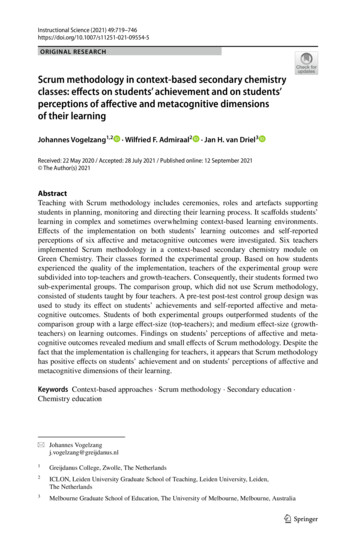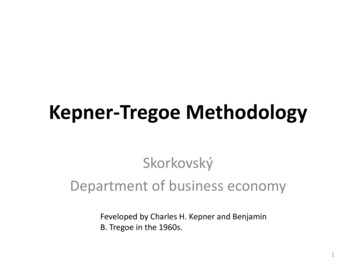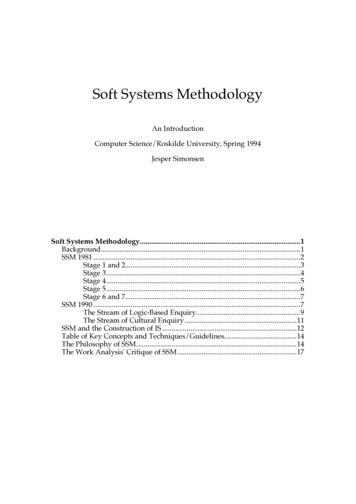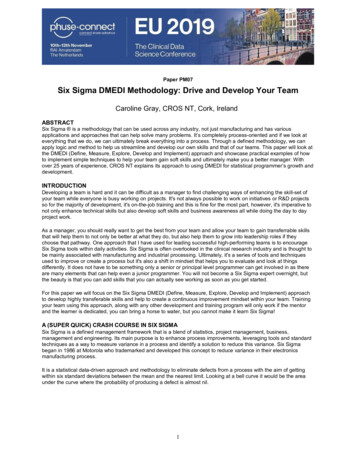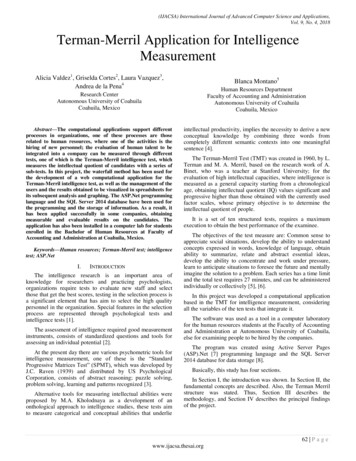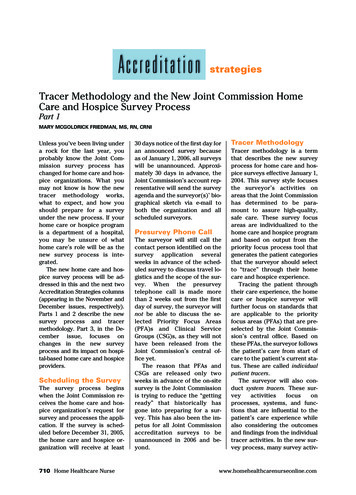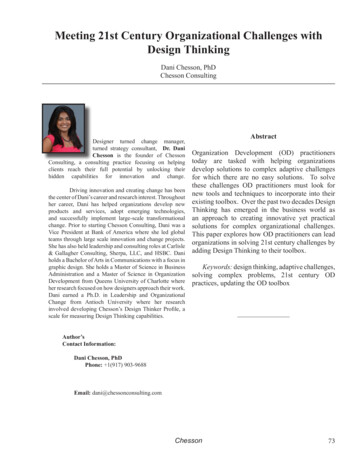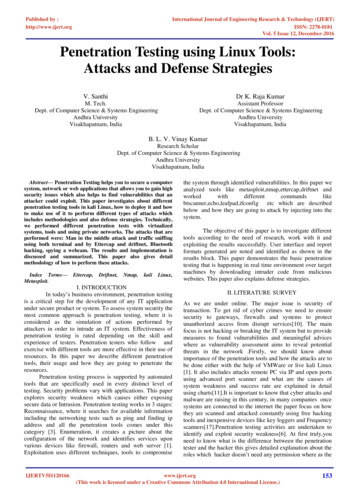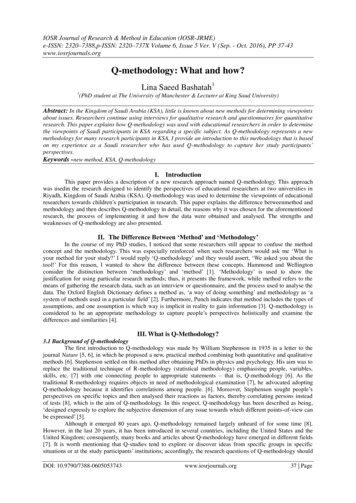
Transcription
IOSR Journal of Research & Method in Education (IOSR-JRME)e-ISSN: 2320–7388,p-ISSN: 2320–737X Volume 6, Issue 5 Ver. V (Sep. - Oct. 2016), PP 37-43www.iosrjournals.orgQ-methodology: What and how?Lina Saeed Bashatah11(PhD student at The University of Manchester & Lecturer at King Saud University)Abstract: In the Kingdom of Saudi Arabia (KSA), little is known about new methods for determining viewpointsabout issues. Researchers continue using interviews for qualitative research and questionnaires for quantitativeresearch. This paper explains how Q-methodology was used with educational researchers in order to determinethe viewpoints of Saudi participants in KSA regarding a specific subject. As Q-methodology represents a newmethodology for many research participants in KSA, I provide an introduction to this methodology that is basedon my experience as a Saudi researcher who has used Q-methodology to capture her study participants’perspectives.Keywords -new method, KSA, Q-methodologyI. IntroductionThis paper provides a description of a new research approach named Q-methodology. This approachwas usedin the research designed to identify the perspectives of educational researchers at two universities inRiyadh, Kingdom of Saudi Arabia (KSA). Q-methodology was used to determine the viewpoints of educationalresearchers towards children‟s participation in research. This paper explains the difference betweenmethod andmethodology and then describes Q-methodology in detail, the reasons why it was chosen for the aforementionedresearch, the process of implementing it and how the data were obtained and analysed. The strengths andweaknesses of Q-methodology are also presented.II. The Difference Between ‘Method’ and ‘Methodology’In the course of my PhD studies, I noticed that some researchers still appear to confuse the methodconcept and the methodology. This was especially reinforced when such researchers would ask me „What isyour method for your study?‟ I would reply „Q-methodology‟ and they would assert, „We asked you about thetool!‟ For this reason, I wanted to show the difference between these concepts. Hammond and Wellingtonconsider the distinction between „methodology‟ and „method‟ [1]. „Methodology‟ is used to show thejustification for using particular research methods; thus, it presents the framework, while method refers to themeans of gathering the research data, such as an interview or questionnaire, and the process used to analyse thedata. The Oxford English Dictionary defines a method as, „a way of doing something‟ and methodology as „asystem of methods used in a particular field‟ [2]. Furthermore, Punch indicates that method includes the types ofassumptions, and one assumption is which way is implicit in reality to gain information [3]. Q-methodology isconsidered to be an appropriate methodology to capture people‟s perspectives holistically and examine thedifferences and similarities [4].III. What is Q-Methodology?3.1 Background of Q-methodologyThe first introduction to Q-methodology was made by William Stephenson in 1935 in a letter to thejournal Nature [5, 6], in which he proposed a new, practical method combining both quantitative and qualitativemethods [6]. Stephenson settled on this method after obtaining PhDs in physics and psychology. His aim was toreplace the traditional technique of R-methodology (statistical methodology) emphasising people, variables,skills, etc. [7] with one connecting people to appropriate statements – that is, Q-methodology [6]. As thetraditional R-methodology requires objects in need of methodological examination [7], he advocated adoptingQ-methodology because it identifies correlations among people. [6]. Moreover, Stephenson sought people‟sperspectives on specific topics and then analysed their reactions as factors, thereby correlating persons insteadof tests [8], which is the aim of Q-methodology. In this respect, Q-methodology has been described as being,„designed expressly to explore the subjective dimension of any issue towards which different points-of-view canbe expressed‟ [5].Although it emerged 80 years ago, Q-methodology remained largely unheard of for some time [8].However, in the last 20 years, it has been introduced in several countries, including the United States and theUnited Kingdom; consequently, many books and articles about Q-methodology have emerged in different fields[7]. It is worth mentioning that Q-studies tend to explore or discover ideas from specific groups in specificsituations or at the study participants‟ institutions; accordingly, the research questions of Q-methodology shouldDOI: 10.9790/7388-0605053743www.iosrjournals.org37 Page
Q-methodology: What and how?be simple, narrow and straightforward [7]. The research question in studies employing Q-methodology isconsidered vital, because it helps to draw the structure of the Q-statements for the researcher and provides aguideline for the participants during the sorting process [9].3.2 Brief explanation of Q-methodologyQ-methodology has been described in generalas, „a set of procedures, theory and philosophy‟ [10].However, a review of the literature yields different definitions of Q-methodologycovering different ideas,including capturing subjectivity, the process of the Q-sort and the extent to which it is a qualitative or a mixedmethod. Wint [6]described the foundation of Q-methodology as the idea of subjectivity but it is not only that; Qmethodology also deals with participants as variables, not as a case study [5]. Furthermore, Watts indicates thata researcher using Q-methodology will find the reflection of the participants‟ perspectives about the topic, whichis what the present research requires, and not their views about themselves [11]. Additionally, Woods considersQ-methodology as, „a methodology developed for small-scale research with the aim of capturing and contrastingsubjectivity‟ [12]. Furthermore, Hughes depicts the Q-methodology process as, „a method that requires aparticipant to sort items according to some kind of criterion‟ [8]. These criteria include elements such as thedegree to which the participants agree, and the items are usually statements presented to the participants oncards.The foundation of Q-methodology is the idea of subjectivity [6], which is based on or influenced bypersonal opinions. In this respect, Størksen and Thorsen statethat, „Q-methodology aims at exploringsubjectivity, i.e. feelings, viewpoints, beliefs, opinions, preferences and values‟ of participants [13].Accordingly, Watts stresses that Q-methodology reflects the participant‟s view, not the researcher‟s view,thereby enabling the researcher to work in the participant‟s world. Q-methodology allows the researcher toexplore participants‟ perspectives and is considered one of the most effective approaches using both qualitativeand quantitative research methods [14]. Additionally, Cross mentions that the Q-sort is a „self-directed process‟[15], indicating that it emerges from the self. Having the participants sort the statements lets them decide what isimportant and valuable from their perspectives [14]. It is also worth mentioning that there are no right or wronganswers for their sorting, because the process shows their perspective about the specific issue. Therefore, Qmethodology is considered to be, „a foundation for the systemic study of subjectivity‟ [10].3.3 Is Q-methodology a quantitative or qualitative approach?There has been debate about whether Q-methodology is a qualitative or quantitative method or a mixedmethod.The results of the literature review indicate that most researchers consider it a mixed method. Hayneclaims that, „Q-methodology, an approach comprising both quantitative and qualitative method, was used toascertain different perceptions amongst the sample‟ [15]. Q-methodology is a mixed method combining thestrong features of each approach. In Q-methodology, the researcher collects the data in a qualitative way andanalyses the data statistically, which is considered a quantitative approach; further, this approach provides morein-depth results [16]. In their nursing research, Akhtar-Danesh et al. found the following:Q-methodology has been identified as a method for the analysis of subjective viewpoints and has thestrength of both qualitative and quantitative methods. It shares with qualitative methodologies the aim ofexploring subjectivity; however, statistical techniques are used to reveal the structure of views [17].Moreover, Davis and Michelle stress that Q-methodology is considered a mixed method because thequalitative researcher sees it as quantitative and the quantitative researcher sees it as qualitative, and also, it is amultidisciplinary approach [18]. Meanwhile, Woods explains that Q-methodology is presented as quantitative,but has a qualitative aim [19]. She also illustrates that the participants in a study using Q-methodology give theresearcher accurate findings by sorting the statements to explore their beliefs and then express their viewsduring interviews. Exploring different views from different groups served as a resource for my drawingconclusions about attitudes and obstacles regarding children‟s participation in research and specifically abouthaving their voices heard and the implementation of ethics procedures.In some ways, discussions about the nature of Q-methodology are less important than having anunderstanding of what Q-methodology achieves. Q-methodology identifies a set of qualitatively differentperspectives on the topic investigated; the perspectives are written up by the researcher to capture themholistically in verbal form, rather than in numbers. These different sets of perspectives are commonly referred toas „voices‟; in other words, Q-methodology is used to identify qualitatively different points of view. Therefore,it is important to sample diverse participants, who can be expected to have wide-ranging and contrastingperspectives.IV. Why Q-Methodology?My contention is that although I see Q-methodology as a mixed method, I do not perceive it as a mixedparadigm. I do not consider it as belonging to a quantitative paradigm for the following reasons:DOI: 10.9790/7388-0605053743www.iosrjournals.org38 Page
Q-methodology: What and how?(i) It deals with subjectivity that has ordinal measurement (statisticians do not consider ordinal dataquantitative).(ii) Sampling is for diversity and there is no aim of making statistical inferences – and this relates to thesampling. Q-methodology does not involve random sampling or aim to obtain a representative sample. Theresults pertain only to the existence of certain perspectives.(iii) The perspectives are then explored as „voices‟ through interviews to flesh out interpretations.(iv) Q-methodology is a mixture of both quantitative and qualitative approaches [4] to conducting studies thatmeasure perspectives using quantitative methods, such as a questionnaire [3] or qualitative methods, such asan interview, which is considered a vital method for gaining the participants‟ perspectives [3, 20].However, whereas the quantitative approach requires a large sample to obtain general findings, thequalitative approach investigates a small population in depth. In contrast, Q-methodology mixes bothapproaches by using a small sample of participants (compared with the quantitative approach) to obtainprofound findings [4]. In addition, Q-methodology is considered as:a bridge between qualitative and quantitativeresearch. It has the same level of mathematical rigor as quantitative methodology, it provides for direct measure,and it has an interpretive component comparable to that of qualitative methodology. It is designed to (a) elicitoperant subjectivity and (b) directly measure the response. It is not about a person. It is of a person [21].All the above reasons were key in choosing this methodology, but the most important reason was tocapture the participants‟ viewpoints that would identify their subjectivity towards the issue, as Hughes mentions:I was keen to go beyond the notion of using method to transfer information from a researchparticipant‟s head into my own, as if I was emptying a vessel. If I was serious about voice, then I needed toexplore and understand approaches that facilitate co-construction between researchers and researched [8].Thus, the Q-sort should identify what the participants‟ perspectives give to the subject, not just theirperspectives in general [6] but the „social viewpoint‟ [7].4.1 Advantages and disadvantages of Q-methodologyIn his research, Hughes identified some advantages of Q-methodology; for instance, it gives theresearcher the opportunity to listen to diverse voices and fosters respect for the participants‟ viewpointsregarding any topic, rather than imposing one‟s views, and for the participants themselves, regardless of whetherthey are adults or children [8]. In addition, Wint mentions that it is a suitable research approach for a sensitivetopic, such as her study on Facebook bothering, where the participants could express their opinions based ontheir experience by sorting the Q-set, without embarrassment [6]. It also strengthens the researcher–participantrelationship; by giving the participants freedom to sort the Q-set, the researcher relinquishes power [6].Moreover, as Plummer states, Q-methodology allows the researcher to collect numbers of shared viewpointsfrom different groups of participants, and after conducting the analysis, the researcher will find that eachviewpoint is heard as an individual voice [22].Some researchers have mentioned that the main disadvantages of Q-methodology are validity andreliability issues, which are important elements of any type of R methodology study [7]. In studies using Qmethodology, validity and reliability can be implemented, but in different ways, such as by asking the sameparticipant to sort the statements more than once; alternatively, validity and reliability sometimes emerge afterthe data analysis is completed, if similar factors arise [7].V. Implementing Q-MethodologyIn my research, the Q-methodology was implemented in six steps:developing a comprehensive set of statements (Q-set)implementing the Q-sortsampling frame (P-set)administering the questionnaireconducting the interviewsdata analysis and interpretation5.1 Developing a comprehensive set of statements (Q-set)In Q-methodology, the most important step is developing the statements [4], known as the Q-set or theQ-sample. It is a set of items given to the participants to sort, often presented as written statements [6], but insome cases, it could be photos, as in Størksen et al.‟s study, which was conducted with four-year-old children[23]. Usually, the statements have to be in the form of numerous statements, as Watts and Stenner mention,„Ideally, items should be presented to participants on sensibly sized and laminated cards of a single colour andstandard appearance‟ [7]. In my study, the Q-set was written on cards. Researchers who use Q-methodologyneed to collect different statements from different sources to explore people‟s opinions about a specific topic [8],which should be representative of the issue, clear, appropriate for the participants, easy to understand andDOI: 10.9790/7388-0605053743www.iosrjournals.org39 Page
Q-methodology: What and how?applicable [15]. For example, Størksen et al. explained that their study was based on the findings of previousstudies on the same topic [13]. Moreover, Watts and Stenner indicate that the key aim of the Q-set is to collectitems that cover the study topic and are linked to the research questions [7].For my study, the statements were informed by my own cultural knowledgeof the KSA, andprofessional experience as a lecturer at King Saud University andwere developed from different sourcesincluding the following:A broad literature review about the issue internationally and in KSA, including books, articles, reports, etc.The findings of my pilot study were obtained via a questionnaire and interviews with Saudi educationalresearchers, postgraduate students from King Saud University, a preschool head teacher and arepresentative from the Ministry of Education.An assignment from my MSc course, where I conducted a focus group with PhD students in the educationschool and an interview with a lecturer who had experience of children‟s participation in research; I letthem talk about their experiences of having children participate in their researchInformal conversations with my colleagues working at King Saud University as educational researchers.My experience as a Saudi educational researcher, who has involved children in research (my MAdissertation)Each statement was paraphrased to present only one idea, in order to make them easy to understand.Furthermore, the researcher should choose positive wording to make the opposite, negative, positive, but in adifferent way. It is preferable to frame the statements in the first person (I). In some studies, like this study,thestatements were used for a highly educated sample, this was considered unnecessary [22].It is important to adopt a framework for the Q-statements, whether a theory or article or book, etc.Thus, to underpin my set of statements (Q-set), I decided to adopt a framework using a book to structure the Qset by drawing on other literature, professional experience, etc. Wint found that, „The process of extracting a Qset from the larger concourse usually involves some sort of classification process where statements are groupedunder broad categories or themes‟ [6]. Moreover, the statements should not overlap, the language must be clearand the researcher must try as much as possible to reduce ambiguity and, finally, the statements must beunderstandable to all [6]. In addition, the number of statements must be minimised, because the standard numberof statements for a study employing Q-methodology is usually between 40 and 80, depending on the topic [7].In summary, it is not only criteria, such as balance and coverage, which determine the size of the Q-set;it is also the number of statements falling within the usual range expected when using Q-methodology. AsWilson mentions, „The researcher presented the Q sample for sorting by several acquaintances in order to gatheropinions regarding the size of the sample, syntax of the statements, and effectiveness of conditions ofinstruction‟ [22]. Moreover, the researcher must ensure that each statement matches with the correct theme ofthe Q-methodology statements, because this increases the internal validity and reliability of the research [4] andprovides balance, boundlessness and coverage for the participants [7]. Making a balance of the statementsmeans providing full coverage of different opinions on the topic, ensuring that they are related to the researchquestions and that each positive statement has a corresponding negative one, but with the same concept – this ismore important than just being positive or negative [7].5.2 Implementing the Q-sortTo implement the Q-sort in my study, six steps needed to be completed, as shown in Fig. 1.Figure 1: The Q-stepsDOI: 10.9790/7388-0605053743www.iosrjournals.org40 Page
Q-methodology: What and how?However, the researcher has a responsibility to inform the participants that there is no right or wrongway to sort these statement cards [7].The Q-sort is the procedure that allows participants to give their own perspectives on an issue byranking statements within a distribution frame allocated by the researcher [6]; thus, the participants organiseeach category (agree and disagree) by sorting the statements according to how much they feel each statementrepresents their view [6]. They then need to choose the two most agreeable statements ( 5) and organise themfrom ( 4) to ( 1) and then do the same for the most disagreeable statements, starting with the two mostdisagreeable statements ( 5), and then place any that they have no opinion about in the (0) column.In general, there are two kinds of Q-sorting distributions: free and forced-choice [7]. Forced-choicedistribution provides the data in a manner resembling normal distribution; this distribution makes the processeasier for the participants and it also represents a convenient means of facilitating the subjective evolutions. Freedistribution, however, although it gives the participants more freedom and space, arguably does not provide theresearcher any extra information and takes more time for the participants to complete as they decide how tomake their distribution decisions [7].For my research, I collected the data from the participants in different ways, as shown in Fig. 1 above. Igave them a short questionnaire to ascertain their demographic information. They then completed the Q-sort,followed by another questionnaire, not an interview, to clarify their statement selection. After analysing the Qsort, I conducted interviews with the two participants who loaded most strongly onto each of the identified„voice‟ profiles. Fig. 2 presents the Q-methodology blank sorting distribution for the educational researchers (54blanks) and Fig. 3 illustrates the Q-sorting process.Figure 2: The distribution shapeThis distribution includes 11 columns for 54 statements. The Q-set statements were typed in bold, black letterswith a 16-pt font size and cut out to 12 cm.Figure 3: Completing the Q-sort5.3 Sampling frame (P-set)Q-methodology participants are described as the P-set [6]. In a study using Q-methodology, theresearcher reveals the selected perspectives from the group of participants [7], and the findings do not depend onthe number of participants but on the general idea of the issue under investigation [24]. However, as Punchindicates, there is no study without sampling, whether it is quantitative or qualitative [3]. The available samplecan generate the data and help to achieve the research aim [3]. For this Q-methodology research, the snowballmethod was appropriate. The snowball method involves, „a small number of individuals who have theDOI: 10.9790/7388-0605053743www.iosrjournals.org41 Page
Q-methodology: What and how?characteristics in which they are interested‟ [20,p.158]. This method, as Hayne notes, is suitable for a studyadopting Q-methodology [4].The Q-participants shouldnumber between 40 and 60, as this is considered theideal range for a Q-methodology study [5]. Moreover, in a Q-methodology study, the number of participantsmust be fewer than the number of statements to ensure that it is a valuable study with data that are easy toanalyse [7].5.4 The questionnaireFor this research, I used a questionnaire rather than an interview to interpret the responses of theparticipants after carrying out the Q-sort. The reason for this was to overcome my problem of distance and avoiddiscussing the issues with my colleagues, because I could be considered as an insider researcher, as I am alecturer at KSU. In addition, the responses to the questionnaire helped me to identify the reasons for theparticipants‟ choices and their opinions on the methodology in general. Furthermore, the questionnaire allowedthe participants to identify any unclear statements and make suggestions for new statements or other ways ofimplementing the Q-methodology in future studies [7].5.5 Conducting the interviewsThe interviews with the educational researchers were considered an essential step of the Qmethodology. I conducted open, informal interviews with the participants who loaded most strongly onto eachof the identified „voice‟ profiles. For example, if the Q-sort identified four voices, then I interviewed eightparticipants. It helped me to explore the strong loading onto one or another of the identified voice profiles bycoding and dividing them into themes based on the statements provided [4] and allowed me to gain a betterunderstanding of the nuances of each identified voice, which further helped me gain a deeper understanding ofthe Q-sort profiles. This kind of interview offered many advantages, as it allowed me to extract moreinformation from the participants, check their perspectives and compare their choices and the factor arrays fromthe analysis [6]. Furthermore, it enabled a wider exploration of the participants‟ perspectives on the ethics ofchildren‟s participation in research, and allowed me to investigate the way the participants placed theirstatements on the distribution and why they chose a particular statement to be the strongest one [7].5.6 Data analysis and interpretationQ-analysis identifies the differences and similarities between participants [4]. Although some statisticalprograms, such as SPSS (now IBM SPSS), can analyse the responses, they are not recommended [7], althoughsome studies have used the SPSS package and obtained similar results to those of Hayne [4]. In this study, thePQMethod software (available for free from www.Irz-muenchen.de/ schmolck/qmethod/) was used forperforming the analysis because it runs on Windows; for instance, the factor arrays are produced by the PQsoftware [7] and the program is easy to use, shows the initial for each person automatically, and the way ofpresenting the factors is straightforward [9]. Each factor shows a pattern of a person‟s perspectives, representingan individual level of statistical correlation, and at the end it shows the pattern of the Q-factors [8]. The factorsappear as a family of subjective responses linked to each other; the Q-factors emerge from a person‟s feelings,thus reflecting their subjectivity, rather than being about themselves [21]. After the analysis, as Ernest mentions,the result illustrates the differences and similarities amongst the groups [25].The PQMethod software gives the researcher the results of the data as numbers for each factor, butdoes not interpret these factors. The interpretative task in Q-methodology involves the production of a series ofsummarizing accounts, each of which explicates the viewpoints being expressed by a particular factor [5]. Theaim of this stage is to read the factors that have emerged as words, not just numbers, and that allows the readerto see the similarities and differences of the participants‟ perspectives [26].VI. Strengths and LimitationsThe strengths and limitations of this methodology depend on the context; in the study at hand, thecontext was the KSA. The strengths focus on the suitable points of the method. Q-methodology helps withexploring participants‟ viewpoints on any new topic in a different way. This method is considered wellorganised and follows clear steps. As one participant in the pilot study commented, „Although I do not have anyidea about the topic, I can share my perspective from reading the statements and sorting them‟. Moreover, manyparticipants commented that the results could not be generalised because of the low number of participants. Theanswer is that the point of Q-methodology is to identify people‟s viewpoints, rather than how many people holdthis viewpoint. Furthermore, this method allows for revealing all the participants‟ voices and does not ignoreany voice, as illustrated throughout the course of the analysis, by presenting the results in factors. Furthermore,in the Q-sorting process, administering a questionnaire to the participants after they completed their Q-sort madethe data collection more time-efficient and simpler than would have been possible through interviewing. Lastly,this method is effective whether the researcher is present or absent during the data collection.DOI: 10.9790/7388-0605053743www.iosrjournals.org42 Page
Q-methodology: What and how?Based on my experience as a Saudi researcher, I can explain the limitations of Q-methodology asfollows. The methodology was new and unfamiliar to the Saudi participants; thus, they needed time tounderstand it, then use it, and they indicated that they did not have time to learn a new skill by recognising theQ-methodology as a method. However, I understand their fear of trying this new approach, since Qmethodology is a new and unfamiliar tool in KSA; consequently, there was a need to simplify the statements inorder to make them perfectly clear for the participants. At the end, when I asked them their opinions on themethod, Q-methodology, their answers were valuable and will help future researchers to keep in mind andaccordingly avoid the problems identified. For example, the participants focused on the number of statements asbeing too large (54 statements); therefore, the decision was made to decrease them in the future. In addition,some of them commented that the Q-methodology process took a long time to complete; thus, it would be betterto undertake the process online.VII.Conclusion and Future RecommendationSince Q-methodology remains uncommon among researchers, this research adds a new study to the Qmethodology community, as few studies using this method have been conducted in the Saudi context. Usingnew methods, such as Q-methodology, can increase the academic community‟s awareness of other methods thatcan be used to explore people‟s perspectives, rather than using existing questionnaire and interview tools.Personally, I hope this article inspires change in the Saudi academic community, enabling the communitymembers to learn about it and use it to conduct their 3][24][25][26]M. Hammond, and J.Wellington, Research methods the key concepts (New York, NY: Routledge, 2013).Oxford English dictionary, 7 (Oxford: Oxford University Press, 2012).K.Punch, Introduction to research methods in education (London: Sage, 2011).A.Hayne, Choose life. Choose a perspective. A q-methodological analysis of different perceptions of drug educationandTrainspotting in small town Scotland, doctoral diss., University of Manchester, Manchester, 1998.P.Stenner, S.Watts, and M.Worell, Q methodology, in W. Stainton Rogers and C. Willig (Eds.), Ha
Q-methodology because it identifies correlations among people. [6]. Moreover, Stephenson sought people‟s perspectives on specific topics and then analysed their reactions as factors, thereby correlating persons instead of tests [8], which is the aim of Q-methodology. In this respect, Q-methodology has been described as being,
